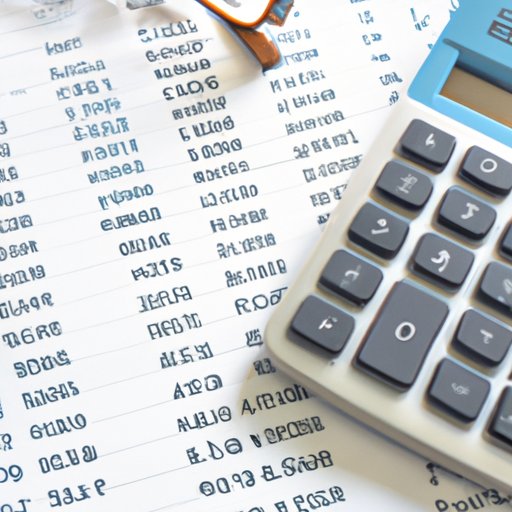Introduction
Cryptocurrency trading is becoming increasingly popular as more people are drawn to the potential of gaining profits from digital assets. As with any form of trading, understanding how to calculate your gains is essential for making informed decisions and staying ahead of the game. This article will provide a comprehensive guide on how to calculate gains in crypto.

Overview of the Different Types of Gains in Crypto
There are several different types of gains that can be earned through cryptocurrency trading. The most common type is capital gains, which is the profit made from buying and selling cryptocurrency. Other types of gains include arbitrage gains (buying and selling the same asset on two exchanges at the same time to take advantage of price differences), staking rewards (earning interest from holding crypto in a wallet or exchange), and mining rewards (receiving rewards for verifying transactions on the blockchain).
Purpose of the Article
The purpose of this article is to provide an in-depth guide on how to calculate gains in crypto, particularly capital gains tax. It will cover a range of topics, including an explanation of capital gains tax, examples of how to calculate gains for different scenarios, accounting for fees and commissions when calculating gains, and best practices for keeping accurate records.
How to Calculate Capital Gains Tax on Crypto Trading Profits
Capital gains tax is a tax on the profits made from buying and selling cryptocurrencies. It is important to understand how capital gains tax works, so you know how much you owe in taxes and can accurately report your gains. Here is a brief overview of capital gains tax and how to calculate it.
Explanation of Capital Gains Tax
Capital gains tax is a tax on the profits made from buying and selling cryptocurrencies. The amount of tax you owe depends on whether the trade was short-term (held for less than one year) or long-term (held for one year or longer). Short-term trades are taxed at your ordinary income tax rate, while long-term trades are taxed at a lower rate. The tax rate also varies depending on your taxable income.
Calculation of Capital Gains Tax for Trades
To calculate the capital gains tax you owe on a trade, you need to subtract the cost basis (the amount you paid for the cryptocurrency) from the proceeds (the amount you received for selling the cryptocurrency). This is your gain or loss. If you have a gain, you multiply it by the applicable tax rate to get the amount of tax you owe. For example, if you have a $1,000 gain and you’re in the 25% tax bracket, you would owe $250 in capital gains tax.
Examples of How to Calculate Gains for Different Scenarios
Now that you understand the basics of capital gains tax, let’s look at some examples of how to calculate gains for different trading scenarios.
Short-Term vs. Long-Term Trades
The first step in calculating gains is to determine whether the trade was short-term or long-term. Short-term trades are held for less than one year, while long-term trades are held for one year or longer. This is important because short-term trades are taxed at your ordinary income tax rate, while long-term trades are taxed at a lower rate.
How to Calculate Gains for Coin-to-Coin Trades
Coin-to-coin trades involve buying one cryptocurrency with another. To calculate the gains, you need to determine the cost basis of both coins and subtract them from the proceeds of the sale. For example, if you bought 1 Bitcoin for 10 Ethereum and sold it for 11 Ethereum, your gain would be 1 Ethereum.
How to Calculate Gains for Token-to-Token Trades
Token-to-token trades involve buying one token with another. To calculate the gains, you need to determine the cost basis of both tokens and subtract them from the proceeds of the sale. For example, if you bought 1 ERC-20 token for 0.1 Ethereum and sold it for 0.2 Ethereum, your gain would be 0.1 Ethereum.
How to Calculate Gains for Token-to-Fiat Trades
Token-to-fiat trades involve buying a token with a fiat currency, such as US dollars. To calculate the gains, you need to determine the cost basis of the token (in USD) and subtract it from the proceeds of the sale (in USD). For example, if you bought 1 ERC-20 token for $10 and sold it for $15, your gain would be $5.

Accounting for Fees and Commissions When Calculating Gains
When calculating your gains, it is important to account for any fees and commissions you paid. These fees and commissions can vary depending on the platform you are using, but they generally include transaction fees, trading fees, and withdrawal fees.
Explanation of Fees and Commissions
Transaction fees are the fees charged by the platform for executing a trade. Trading fees are the fees charged by the platform for placing an order. Withdrawal fees are the fees charged by the platform for withdrawing funds from your account. It is important to factor these fees into your calculations to ensure accuracy.
How to Account for Fees and Commissions When Calculating Gains
When calculating your gains, you need to subtract any fees and commissions you paid from the proceeds of the sale. For example, if you bought 1 ERC-20 token for 0.1 Ethereum and sold it for 0.2 Ethereum, but paid a 0.01 Ethereum fee, your gain would be 0.09 Ethereum.

Best Practices for Keeping Accurate Records of Your Gains
It is important to keep accurate records of your gains for tax purposes. Here are some best practices for keeping accurate records.
Importance of Keeping Accurate Records
Keeping accurate records of your gains is essential for filing taxes correctly and avoiding penalties. You should keep track of all your trades, including the date, time, amount, and price of each trade. You should also keep track of any fees and commissions you paid.
Best Practices for Keeping Records
The best way to keep records is to use an automated system such as a spreadsheet or a tracking app. This will make it easier to track all your trades and keep accurate records. You should also keep copies of all your tax documents, such as receipts and invoices, in case you need to refer to them later.
Resources for More Detailed Information About Calculating Gains in Crypto
If you want to learn more about calculating gains in crypto, here are some recommended resources:
- The IRS website has detailed information about capital gains tax and how to calculate it.
- CoinTracker is a free online tool for tracking and calculating your crypto taxes.
- The CryptoTaxCalculator blog has helpful articles on crypto tax tips and strategies.
- The CryptoTrader.Tax blog has useful guides on calculating crypto taxes.
Conclusion
Understanding how to calculate your gains in crypto is essential for making informed decisions and staying ahead of the game. This article provided a comprehensive guide on how to calculate gains in crypto, including an explanation of capital gains tax, examples of how to calculate gains for different scenarios, accounting for fees and commissions when calculating gains, and best practices for keeping accurate records. We also listed some resources for more detailed information about calculating gains in crypto.
(Note: Is this article not meeting your expectations? Do you have knowledge or insights to share? Unlock new opportunities and expand your reach by joining our authors team. Click Registration to join us and share your expertise with our readers.)
